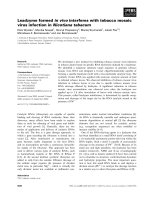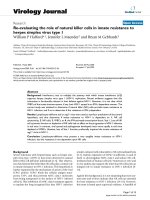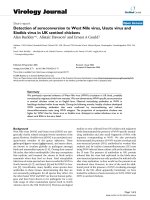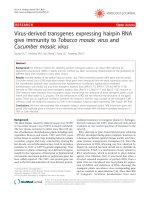Investigation of resistance to tobacco mosaic virus desease on tomato by dna marker
Bạn đang xem bản rút gọn của tài liệu. Xem và tải ngay bản đầy đủ của tài liệu tại đây (1.16 MB, 51 trang )
VIETNAM NATIONAL UNIVERSITY OF AGRICULTURE
FACULTY OF BIOTECHNOLOGY
--------------
GRADUATION THESIS
TITLE:
“INVESTIGATION OF RESISTANCE TO TOBACCO
MOSAIC VIRUS DISEASE ON TOMATO
BY DNA MARKER”
Hanoi - 2022
VIETNAM NATIONAL UNIVERSITY OF AGRICULTURE
FACULTY OF BIOTECHNOLOGY
--------------
GRADUATION THESIS
TITLE:
“INVESTIGATION OF RESISTANCE TO TOBACCO
MOSAIC VIRUS DISEASE ON TOMATO
BY DNA MARKER”
Student
: Nguyen Thi Hong Hai
Student’s code
: 637410
Class
: K63CNSHE
Major
: Biotechnology
Supervisor
: Pham Thi Dung, Ph.D
Hanoi - 2022
GUARANTEE
I hereby declare that this thesis is completely done by my scientific
research under the guidance of Mrs. Pham Thi Dung Ph.D. Faculty of
Biotechnology - Vietnam National University of Agriculture. All figures in this
thesis are true and do not duplicate the results of any previous graduate report.
The graduation thesis has references to documents, citation information is
recorded in the references section.
I take responsibility for my promises to the faculty and the university.
Hanoi, December 2022
Student
Nguyen Thi Hong Hai
i
Acknowledgments
First, in completing this research paper, I received plenty of help,
guidance, and encouragement from teachers and friends.
First of all, I would like to express my deepest thanks to my supervisor,
Mrs. Pham Thi Dung who has given me suggestions on how to shape the study
and has always been most willing and ready to give my valuable advice, helpful
comments as well as correction of my research paper.
Next, I would like to express my gratitude to all teachers in the
Biotechnology faculty- at the Vietnam National University of Agriculture for
their lectures for 4,5 years that help me in completing this paper. Besides that,
I’m so thankful for all the support and encouragement of Mr. Phan Huu Ton and
your employees at the Center for Conservation and Development of Plant
Genetic Resources who helped and created the most favorable conditions for me
during my thesis.
Last but not least, I would like to thank my family and my friends who
have always encouraged, supported, and helped me to complete this paper
Hanoi, December 2022
Student
Nguyen Thi Hong Hai
ii
TABLE OF CONTENT
GUARANTEE ....................................................................................................... i
ACKNOWLEDGMENTS..................................................................................... ii
LIST OF TABLES ................................................................................................ v
LIST OF FIGURES .............................................................................................. vi
ABBREVIATIONS ............................................................................................. vii
ABSTRACT ....................................................................................................... viii
CHAPTER I: INTRODUCTION ...................................................................... 1
1.1. Rationale..................................... Lỗi! Thẻ đánh dấu không được xác định.
1.2. Aims and requirements of study .................................................................... 3
1.2.1 Aims ............................................................................................................. 3
1.2.2. Requirements ............................................................................................... 3
CHAPTER II: LITERATURE REVIEW......................................................... 4
2.1. Introduction .................................................................................................... 4
2.1.1 The origin ..................................................................................................... 4
2.1.2. Nutritional values ........................................................................................ 5
2.1.3. Characteristics of tomato plants .................................................................. 6
2.2. The situation of tomato production in the world and in the country ............. 7
2.2.1. The situation of tomato production in the world ........................................ 7
2.2.2. The situation of tomato production in Vietnam .......................................... 9
2.3. Tobacco mosaic virus disease on tomato ..................................................... 10
2.3.1. Symptoms and signs of disease ................................................................. 11
2.3.2. The cause to the tobacco mosaic virus disease ......................................... 11
2.3.3. Disease Cycle and Epidemiology ............................................................. 13
2.3.4. Epidemiology ............................................................................................ 14
2.4. Status of research on resistance to tomato mosaic virus disease in tomatoes .... 15
CHAPTER III: RESEARCH MATERIALS AND METHODS .................. 18
3.1. Research Materials ....................................................................................... 18
3.1.1. Research subjects ...................................................................................... 18
iii
3.2.1. Place and time of study ............................................................................. 19
3.2. Research content .......................................................................................... 20
3.3.1. Experimental layout .................................................................................. 20
3.3.2. Methods for assessing important agronomic traits ................................... 21
3.3.3. Evaluation of resistance to tomato mosaic virus disease of selected
tomato varieties by using molecular markers. ................................................ 22
CHAPTER IV: RESULTS AND DISCUSSION ............................................ 25
4.1. Survey on genetic diversity of researched tomato varieties......................... 25
4.1.1. Growth stages of tomato plants ................................................................. 25
4.1.2. Results on some structural features ........................................................... 26
4.1.3. Investigate the characteristics of inflorescence structure, bloom
characteristics, yield, and yield factors. .......................................................... 29
4.2. Results of the PCR method to detect the Tm-2 gene in the studied tomato
group 4.2.1. Test of DNA total ....................................................................... 32
4.2.2. Determination of DNA content by OD spectroscopy of total DNA ......... 34
4.2.3. Results of PCR products detecting Tm-2 gene ......................................... 35
CHAPTER V: CONCLUSIONS AND RECOMMENDATIONS ................ 39
5.1. Conclusions .................................................................................................. 39
5.2. Recommendations ........................................................................................ 39
REFERENCES .................................................................................................... 40
iv
LIST OF TABLES
Table 2.1 Composition of Dry Matter Content of Tomato5
Table 2.2. Area harvested, yield, and production over the world of tomatoes .... 9
Table 3.1 Name of tomato varieties stored at the Center for Conservation and
Development of Plant Genetic Resources. ......................................... 18
Table 3.2. PCR reaction components ................................................................. 24
Table 3.3. PCR conditions for different primer pairs. ........................................ 24
Table 3.4. List primer ......................................................................................... 24
Table 4.1. The stages of growth and development of tomatoes ......................... 25
Table 4.2. Some growth characteristics, morphological characteristics, and
tree structure of the studied varieties .................................................. 27
Table 4.3. Some characteristics of inflorescence structure, bloom
characteristics, yield and yield factor ................................................. 31
Table 4.4. Determination of DNA content by OD spectroscopy of total DNA . 34
Table 4.5. Selection of promising varieties ........................................................ 38
v
LIST OF FIGURES
Figure 2.1. Anatomical morphology of tomato stem, flower, fruit...................... 7
Figure 2.2. Tomato production of countries in the world in 2020 ....................... 8
Figure 2.3. Tobacco mosaic virus disease on tomato leaf ................................. 10
Figure 2.4. Signs of tobacco mosaic virus disease on tomato leaf and fruit ...... 11
Figure 2.5. The rod-shaped virus particles of TMV .......................................... 10
Figure 2.6. A single TMV particle ..................................................................... 10
Figure 2.7. Transcriptional process of TMV ...................................................... 13
Figure 4.1. Test of DNA total ............................................................................ 32
Figure 4.2 Results of PCR products detecting Tm-2 gene by primer Tm2RS-2 35
Figure 4.3 Results of PCR products detecting Tm-2 gene by primer Tm2RS-3 36
Figure 4.4 Results of PCR products detecting Tm-2 gene by primer Tm2S-1 .. 36
Figure 4.5 Results of PCR products detecting Tm-2 gene by primer Tm2S-2 .. 37
vi
ABBREVIATIONS
ToMV
Tomato mosaic virus
TMV
Tobacco virus
MAS
Marker-assisted selection
CAPS
Cleaved amplified polymorphic sequence
SNP
Single nucleotide polymorphism
RdRP
RNA-dependent RNA polymerase
MP
The movement protein
FAO
The Food and Agriculture Organization of the United Nations
CP
Coat protein
RAPD
Random amplified polymorphic DNA
SCAR
Sequence characterized amplified region
vii
ABSTRACT
Tomato mosaic virus (ToMV) is one of the most serious virus diseases
not only in tomatoes, but also in many plants, such as cucumber. Infecting
ToMV disease, plants always reduce growth, development, and yield. Using
pesticide, one of the methods, can control the development of this disease.
However, this way can affect tohuman, environmental condition, etc, due to the
pesticitide may resist in product and soil. Finding the resistant genes to ToMV
disease from wild tomato type using DNA markers are optimal method. By the
way, can reduce time and cost for creating new tomato varieties.
From the survey of 20 tomato varieties, some tomato varieties have been
drawn with many good agro-biological characteristics, high yield is 5-8, 10-10(2),
5-10 x 2-4, 2-5, 3-1, 13-7, 11-9, 10-4(2), 14-5(1), 5-9, and 12-2. By using DNA
markers for research and analysis, two varieties with outstanding agro-biological
characteristics and containing genes for resistance to tobacco mosaic virus
disease were found such as 11- 9 and 10-4(2). These two tomato varieties will be
used as a prerequisite for the selection process of breeding resistant to tobacco
mosaic disease on tomato.
viii
CHAPTER I: INTRODUCTION
1.1.
Rationale
On a worldwide scale, the tomato (Lycopersicon esculentum) continues to
increase in importance for consumption as a fresh crop, for inclusion as a major
constituent in many prepared foods, and also for research into the fundamental
principles of growth and development in plants. Members of the Lycopersicon
are tolerant of a wide range of environmental and nutritional conditions. A few
of the species have been crossed to provide a large number of varieties directed
towards either the production of a single-harvest field crop or, particularly under
protection, a succession of fruit for the fresh market over quite a long timespan.
Field tomatoes are amenable to mechanical harvesting through the combined
efforts of plant breeders and agricultural engineers, thus allowing vast tonnages
to be grown and processed economically. The products are incorporated into a
wide range of canned, frozen, preserved, or dried foods. Given their economic
importance, and because they are amenable to molecular biology and genetic
engineering techniques, tomato fruit has been selected for intense study at the
molecular level over the last decade. However, the tomato production process is
still facing many difficulties, one of the causes limiting product development
and reducing tomato yield is tobacco mosaic virus disease. Tobacco mosaic
virus disease has been studied for a long time, but so far, the disease is still a
common pest and greatly affects tomato yield and quality.
Many vegetable and ornamental crops can be infected by tobamoviruses.
Infections usually give rise to characteristic mosaic symptoms and lead to
considerable cosmetic damage and yield losses. Tobamoviruses, including
tobacco and tomato mosaic virus (TMV and ToMV, respectively) belong to the
α-like supergroup of viruses. They consist of a characteristic proteinaceous rod
comprising 2140 coat protein (CP) copies, which envelop the positive-stranded
linear RNA genome. After infection of the plant cell the RNA genome is
uncoated and the viral gene products, the RNA-dependent RNA polymerase
1
(RdRP), the movement protein (MP), and the coat protein (CP), are produced.
Infection of neighboring cells commences with the movement of RNA-MP
complexes through plasmodesmata with MP-induced altered size exclusion
limits. Long-distance transport of the virus proceeds through the vascular tissue
and depends both on MP and CP. Tobamoviruses, especially TMV, are the
classical model system for the study of virus infection in plants
(Mamidala & Nanna,
2009).
Currently, disease control is still mainly by chemical methods. However,
the abuse of chemical drugs has caused consequences such as environmental
pollution, creating resistance to pests and diseases, and affecting human and
livestock health. Therefore, finding effective safety measures to prevent tobacco
mosaic virus disease is one of the urgent issues today.
Breeding new varieties with genetic resistance to tobacco mosaic virus
disease is the most effective way to minimize the damage. Therefore, the
efficient use of new resistance genes by breeders is essential. Researchers have
identified tobacco mosaic virus disease resistance genes for decades, including
Tm-1, Tm-2, Tm-22 in wild tomato species (Pelham, 1965).
Today, in plant breeding, the selection method thanks to molecular
markers linked to the target genes have become an effective tool that can
quickly, early, and accurately select traits regardless of the environment.
Although some tomato lines resistant to late blight have been selected, the
results are still very limited and need to be further researched.
Starting from the above basis, to serve the selection and breeding of
tomato varieties carrying tobacco mosaic virus disease resistance genes, we
conducted the project: " Investigation of resistance to tobacco mosaic virus
disease on tomato by DNA marker."
2
1.2.
Aims and requirements of the study
1.2.1 Aims
Detecting genetic resources to identify tomato varieties with good yield
and quality, containing genes for resistance to tobacco mosaic virus disease for
breeding program.
1.2.2. Requirements
- Evaluation of some important agrobiological traits in tomato corporations.
- Using molecular markers to identify tobacco mosaic virus disease
resistance genes in tomato consortium.
3
CHAPTER II: LITERATURE REVIEW
2.1. Introduction
2.1.1 The origin of tomato
Almost all tomato cultivars are members of the Lycopersicon esculentum
species. The beginnings and the early events of domestication are mostly
unknown, much like with domesticated plants in general. Three things are
certain enough to be fairly assumed. First off, all related wild tomato species are
endemic to the Andean area, which today includes parts of Chile, Colombia,
Ecuador, Bolivia, and Peru. This means that the cultivated tomato is a New
World invention. Second, before being brought to Europe, the tomato was
domesticated to a very advanced state. Early herbals' woodcut illustrations show
that the first varieties grown in Europe produced big fruit. The fruit (in all wild
species) is tiny. The descriptions indicated that a good number of sizes, forms,
and colors were known. Third, the most likely ancestor, the wild cherry tomato
(L. esculentum variety cerasiforme), is spontaneous throughout tropical and
subtropical America and has spread throughout the Tropics of the Old
World(Pelham, 1965).
The time, place, and other aspects of domestication are far less certain.
Mexico is likely the region of domestication, even though concrete evidence is
absent. This is supported by the weight of data from a variety of fields.
Hereditary enzyme comparisons show much greater similarity between older
European cultivars and the indigenous cherry tomatoes of Mexico and Central
America than between European cultivars and the indigenous plants of the
Andes, which is unquestionably the genus Lycopersicon's distribution center and
the other potential domestication region. Portions of the tomato plant have not
been discovered in the archaeological remains of the Andean region, but parts of
the majority of the locally cultivated plants have. Neither have representations
of the tomato been discovered in ancient pottery or other artifacts from the
region. The tomato has no native name in the Andean region, whereas it is
4
known in the Nahua tongue of Mexico as “tomatl”, which is unquestionably the
origin of the modern name (Rick, 1978).
2.1.2. Nutritional values
After potatoes and sweet potatoes, tomatoes are the greatest vegetable
crop in the world, but it is the most popular canned vegetable. It is a significant
condiment and a very affordable source of vitamins in the majority of diets.
Additionally, it contains a significant amount of water (%), calcium (%), and
niacin (%), all of which are crucial for human metabolism. The body benefits
greatly from the vitamins A, C, and E and minerals included in tomatoes, which
help to keep the body healthy and prevent sickness (Olaniyi et al., 2010).
Table 2.1 Composition of Dry Matter Content of Tomato (Petró-Turza, 1986)
Constituent
%
Fructose
25.0
Glucose
22.0
Saccharose
1.0
Citric acid
9.0
Malic acid
4.0
Protein
8.0
Dicarboxylic amino acid
2.0
Pectic substances
7.0
Cellulose
6.0
Hemicellulose
4.0
Minerals
8.0
Lipids
2.0
Ascorbic acid
0.5
Pigments
0.4
Other amino acids, vitamins, and polyphenols
1.0
Volatiles
0.1
5
2.1.3. Characteristics of tomato plants
According to the report of Thi et al., 2017, tomato is a drought-tolerant
variety and has the ability to grow well in normal natural conditions. Some of
the characteristic botanical properties of tomatoes include:
Roots: The root system is clustered, deeply rooted, and strongly branched,
the ability to develop secondary roots is very large. After 2 months of planting,
the roots were widely distributed in the topsoil with a thickness of 60 cm, most
concentrated in the soil layer 30 cm from the surface. Under field conditions,
tomato roots can be eaten up to 1.3 m wide and up to 1 m deep. With such a
large root mass, tomatoes are classified as drought-tolerant. The root system is
shallow or deep, and strong or weak growth is related to the degree of branching
and development of the aboveground parts. Therefore, it is necessary to prune
the branches and press the appropriate tops for the favorable development of
tomato roots.
Stem: The stem is round, succulent, and covered with many dragons,
when the tree is large, the trunk turns to wood. The characteristic of a tomato is
that it spreads around or grows into a bush. Based on the growth characteristics,
tree height can be classified into 3 types: dwarf type (under 65cm), medium type
(65-120cm), and tall type (from 120-200cm). In the process of growing, tomato
plants will grow a lot of axillary buds making the tree dense, so in production, it
is necessary to prune branches to concentrate nutrients on fruit.
Leaves: Tomato leaves are the morphological feature that distinguishes
one variety from another. Most tomato leaves are compound leaves, each
complete leaf consists of 3-4 pairs of leaflets. In between pairs of leaflets, there
is also a middle leaf, on the base of the leaflet there are small leaves called
lateral leaves. Depending on the variety, tomato leaves have different colors and
sizes.
Flowers: Tomato flowers belong to the complete flower category. Flowers
grow in clusters, hermaphroditic, and self-pollinating. Tomatoes are self-
6
pollinating mainly due to the structural features of the flowers. Tomato flowers
secrete a lot of alkaloid toxins, so they are not attractive to insects and heavy
pollen grains, so it is difficult for cross-pollination to occur. In tomatoes, the
number of inflorescences/plants ranges from 4-20 bunches, and the number of
flowers/inflorescences ranges from 2-26 flowers.
Fruit: Tomatoes are berries. The fruit usually has 2, 3, or more seed
compartments. The shape and color of the fruit depending on the variety. In
addition, the color of ripe fruit depends on temperature conditions, carotene, and
lycopene content. The weight of tomato fruit varies greatly from 3 to 200g
depending on the variety
Figure 2.1. Anatomical morphology of tomato stem, flower, fruit.
( />2.2. The situation of tomato production in the world and in the country
2.2.1. The situation of tomato production in the world
Tomato is one of the fruits and vegetables that are widely used all over
the world, in everyday dishes and in the processing industry. According to
statistics, tomato planting areas, production as well as productivity have
increased over the years. According to the Food and Agriculture Organization of
the United Nations (FAO), total world tomato production in 2020 is estimated at
7
186.821 million tons, up 1.02% from 183.014 million tons in 2019. On a global
scale, the production of fresh tomatoes annually amounts to about 180 million
tons. Meanwhile, the number of potatoes is more than twice and four times that
of rice grown around the world (FAO, 2020). However, about a quarter of that
160 million tons is grown for the processing industry, which makes tomatoes the
top processed vegetable in the world. Nearly 39 million tons of tomatoes are
processed each year in factories belonging to the biggest brands in the global
food industry. China is by far the largest tomato producer in the world. In 2020,
the whole country produced approximately 64.77 million tons. This figure is
about 3 times higher than the second place on the list of India with 20.57 million
tons. The third place is the US with 12.23 million tons (FAO, 2020).
Figure 2.2. Tomato production of countries in the world in 2020
( />According to the latest statistics of FAO (2020), the tomato production
area in 2020 will reach 5.05 million hectares, the growth rate in the production
area is slow, always maintaining the production area of about over 2 million
hectares throughout the year. 3 years (2015 - 2017). However, the area increased
8
to 10 million hectares in 2018 and decreased to 5 million hectares in 2020.
Meanwhile, tomato production increased continuously from 176.51 million tons
(2015) to 186.82 million tons (2020). The area, yield, and production of
tomatoes in the world from 2015 to 2020 are shown in Table 2.2.
Table 2.2. Area harvested, yield, and production over the world of tomatoes
Year
Area harvested (ha)
Yield (hg/ha)
Production (tonnes)
2015
4824192
365881
176508179
2016
4854457
365402
177382876
2017
4876142
365092
178024027
2018
5004555
360135
180231376
2019
4999181
366090
183014805
2020
5051983
369798
186821216
(Source: FAO 2020)
2.2.2. The situation of tomato production in Vietnam
Tomato has introduced to Vietnam more than 100 years ago but has
become a popular and widely used vegetable. In the period from 2009 to now,
the tomato variety has had a significant selection. High-yielding varieties with
semi-finite forms, high yield, with many good qualities have been widely used
in many provinces. In the survey of Dr. Pham Dong Quang et al. (2006), the
country currently has about 115 varieties of tomatoes planted, of which 10
varieties are planted with an area larger than 6259 ha, accounting for 55% of the
total area. nationwide. The tomato growing area in our country is maintained at
about 20 to 24 thousand hectares.
The area of tomatoes in recent years has fluctuated between 23-25
thousand hectares, of which Lam Dong has the largest area of about 7000
hectares/year. In 10 2018, the tomato production area reached 24156.5 hectares
with an output of 660.6 thousand tons, and the average yield was 27.4 tons/ha
(GSO, 2019).
9
2.3. Tobacco mosaic virus disease on tomato
The tobacco mosaic virus (TMV) causes serious loss of yield and fruit
quality in commercial tomato crops. Much has been written during the last 50
years on its effects, spread, control, and elimination, and this literature has
recently been reviewed by Broadbent (1961). Holmes (1960) has discussed the
principles of controlling certain tomato viruses, including TMV, by the use of
resistant varieties. Since resistance to TMV in a wild species was first reported
in 1939, there have been many studies on its inheritance and numerous attempts
to exploit it (Pelham, 1965).
The first mention of any form of resistance to TMV in a wild species of
tomato was that made by Porte et al. (1939) who found that plants of
Lycopersicon hirsutum grown from seed collected in South America by Blood
and Tremelling in years 1937 – 1938 were symptomless even though virus was
present in their tissues. Hybird of this material with L. esculentum, the cultivated
species, were found to have a lower level of tolerance to TMV than the wild
species (Doolittle 1949).
Alexander (1948) used this material and states that the accession number
was P.I> 126445 (personal communication). His attempts to recover resistant
plants of L. esculentum type from crosses involing this materials were
unsuccessful, but a promissing line with resistance was devoloped by
J.M.Walter (Barden et al., 1986).
Figure 2.3. Tobacco mosaic virus disease on tomato leaf
( />
10
2.3.1. Symptoms and signs of disease
Symptoms induced by Tobacco mosaic virus (TMV) are somewhat
dependent on the host plant and can include mosaic, mottling, necrosis, stunting,
leaf curling, and yellowing of plant tissues. The symptoms are very dependent
on the age of the infected plant, the environmental conditions, the virus strain,
and the genetic background of the host plant. Strains of TMV also infect tomato,
sometime causing poor yield or distorted fruits, delayed fruit ripening, and
nonuniform fruit color (Motoyoshi & Oshima, n.d.).
Figure 2.4. Signs of tobacco mosaic virus disease on tomato leaf and fruit
( />2.3.2. The cause to the tobacco mosaic virus disease
Hosts for TMV include tomato, and other solanaceous plants. Currently,
yield losses for tobacco due to TMV are estimated at only 1% because resistant
varieties are routinely grown. In contrast, losses of up to 20% have been
reported for tomato. In addition, poor fruit quality may reduce the value of the
crop on the commercial fresh market (Scholthof, 2004).
11
Figure 2.5. The rod-shaped virus particles of TMV
( />TMV is the type member of a large group of viruses within the genus
Tobamovirus. The rod-shaped virus particles (virions) of TMV measure about 300
nm x 15 nm (Figure 2.5). A single TMV particle is composed of 2,130 copies of
the coat protein (CP) that envelope the RNA molecule of about 6,400 nucleotides
(Figure 2.6). This single-stranded RNA encodes four genes: two replicaseassociated proteins that are directly translated from the TMV RNA, and the
movement protein and a coat protein that are translated from subgenomic RNAs
(Scholthof, 2004).
Figure 2.6. A single TMV particle
( />
12
2.3.3. Disease Cycle and Epidemiology
Transmission from plant to plant
TMV is very easily transmitted when an infected leaf rubs against a leaf
of a healthy plant, by contaminated tools, and occasionally by workers whose
hands become contaminated with TMV after smoking cigarettes. A wounded
plant cell provides a site of entry for TMV. The virus can also contaminate seed
coats, and the plants germinating from these seeds can become infected. TMV is
extraordinarily stable. Purified TMV has been reported to be infectious after 50
years storage in the laboratory at 4°C/40°F (Rast, 1975).
Replication
TMV enters the plant cell through minor wounds. Once TMV enters the
cell, the virus particles disassemble in an organized manner to expose the TMV
RNA. The virus RNA is positive-sense, or "+ sense", and serves directly as a
messenger RNA (mRNA) that is translated using host ribosomes. Translation of
the replicase-associated proteins (RP) 126- and 183-kDa) begins within a few
minutes of infection (Young et al., 1988).
As soon as these proteins have been synthesized, the replicase associates
with the 3' end of the + sense TMV RNA for the production of a negative sense,
or "- sense", RNA. The - sense RNA is the template to produce both full-length
genomic + sense RNA as well as the + sense subgenomic RNAs (sgRNAs)
(Fraser & Loughlin, n.d.).
Figure 2.7. Transcriptional process of TMV
( />
13
The sgRNAs are translated by the host ribosomes to produce the
movement protein (MP) (30 kDa) and the coat protein (CP) (17.5 kDa). The coat
protein then interacts with the newly synthesized + sense TMV RNA for
assembly of progeny virions (Kumar et al., 2011).
These virus particles are very stable and, at some point when the cells are
broken or the leaf dries up, they are released to infect new plants. Alternatively,
the + sense TMV RNA is wrapped in movement protein, and this complex can
infect adjacent cells (Nelson1988, n.d.).
Movement in the infected plant
TMV uses its movement protein to spread from cell-to-cell through
plasmodesmata, which connect plant cells. Normally, the plasmodesmata are too
small for passage of intact TMV particles.
The movement protein (probably with the assistance of as yet unidentified
host proteins) enlarges the plasmodesmatal openings so that TMV RNA can
move to the adjacent cells, release the movement protein and host proteins, and
initiate a new round of infection. As the virus moves from cell to cell, it
eventually reaches the plant's vascular system (veins) for rapid systemic spread
through the phloem to the roots and tips of the growing plant (MasoomiAladizgeh et al., 2019).
2.3.4. Epidemiology
The TMV disease cycle and its epidemiology are intimately related
because the virus is completely dependent on the host for replication and spread.
There is wide variation in disease incidence, depending on the time of disease
onset in the field and on cropping practices. For example, a few plants could
become infected early in the season, either from TMV on the seed coat or by
workers contaminating plants. The disease could then spread rapidly throughout
the field or greenhouse by TMV-infected plants contacting healthy plants, or by
equipment or workers. TMV can also survive or overwinter in infected plant
14
debris or perennial (weedy) hosts and, perhaps, in the soil. Agricultural
practices, such as continuous cropping, have the potential to be a particular
problem, especially in greenhouse facilities, where TMV inoculum may increase
in more than one plant species(Whitham et al., 1996).
2.4. Status of research on resistance to tomato mosaic virus disease in tomatoes
In 1898, Martinus W. Beijerinck, of the Netherlands, put forth his
concepts that TMV was small and infectious. Furthermore, he showed that TMV
could not be cultured, except in living, growing plants. This report, suggesting
that 'microbes' need not be cellular, was to forever change the definition of
pathogens. In 1946, Wendall Stanley was awarded the Nobel Prize for his
isolation of TMV crystals, which he incorrectly suggested were composed
entirely of protein. Research by F.C. Bawden and N. Pirie, in England, during
the same period correctly demonstrated that TMV was actually a
ribonucleoprotein, composed of RNA and a coat protein. By the mid-1950s,
scientists in Germany and the United States proved that the RNA alone was
infectious. This discovery ushered in the modern era of molecular virology.
TMV is known for several 'firsts' in virology, including the first virus to be
shown to consist of RNA and protein, the first virus characterized by X-ray
crystallography to show a helical structure (Figure 2.6), and the first virus used
for electron microscopy (Figure 2.5), solution electrophoresis and analytical
ultracentrifugation. TMV also was the first RNA virus genome to be completely
sequenced, the source of the first virus gene used to demonstrate the concept of
coat protein mediated protection, and the first virus for which a plant virus
resistance gene (the N gene) was characterized. Today, TMV is still at the
forefront of research leading to new concepts in transgenic technology for virus
resistance and developing the virus to act as a 'work horse' to express foreign
genes in plants for production of pharmaceuticals and vaccines (Dax et al.,
1994).
15









